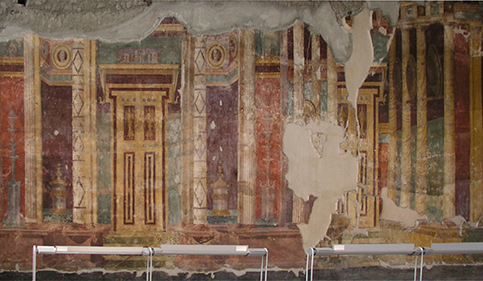 1
1Citing Room 16 in the Villa dei Misteri (Villa Item) is somewhat puzzling because although it does contain two 'closed doors' they are placed at either end of a bed alcove and could not therefore relate to any know stage configuration. Once again it is clear that these doors lead to sanctuaries and not royal palaces.
Had the wall-paintings in the atrium of the Villa di Poppae been available to Little at the time he wrote his Scaenographia article, he might well have cited them as yet further evidence of tragic stage sets (fig.1). Both the lateral walls feature two closed door motifs set into highly ornate architectural facades. But once again the surrounding symbolism indicates that these doors are linked to divine presences or ancestor commemoration, rather than earthly beings, royal or otherwise. In which case the closed doors function within a symbolic realm designed to assuage tragedy and not to act as a background for its dramatisation. The symbol that clearly defines this is the winged victory above the closed door in the triclinium of P. Fannius Synistor, which is depicted transporting the crown of victory skyward (fig.2). This image is also repeated within the tholos in the Casa del Labirinto painting, with the winged victory replaced by the equally poignant image of the eagle (fig.3). Franz Cumont in After Life in Roman Paganism tells us that "...an eagle, preparing for flight and holding the crown of victory, is a usual motif of sepulchral decoration"... " This soul-bearing eagle passed to Italy with the ceremonial of the apotheosis." and "This kind of aviation was not peculiar to monarchs" (Cumont 1922 : 159). The 'sepulchral' closed door connotation, akin to Egyptian and Etruscan (et al) false-doors, is further substantiated by vignettes placed above closed doors in the Villas Synistor and Poppea. The former depicts the hunt for the Calydonian wild boar, a motif commonly reproduced on ancient sarcophagi and the latter depicts a street of tombs, not unlike the tomb lined streets leading into Pompeii.
Therefore Little is correct in perceiving a link between closed door wall-paintings and tragedy, but it is not the type of tragedy associated with the theatre in which the audience witnesses the tragedies that befall the mighty and those associated with them. The tragic connotations associated with these closed door wall-paintings are far more domestically located, as were the wall-paintings themselves.
 1
1
|